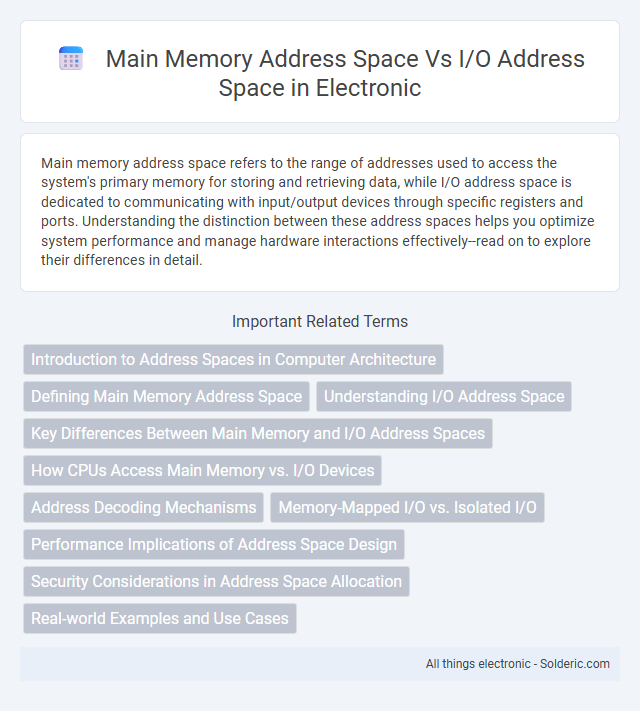Main memory address space refers to the range of addresses used to access the system's primary memory for storing and retrieving data, while I/O address space is dedicated to communicating with input/output devices through specific registers and ports. Understanding the distinction between these address spaces helps you optimize system performance and manage hardware interactions effectively--read on to explore their differences in detail.
Comparison Table
| Feature | Main Memory Address Space | I/O Address Space |
|---|---|---|
| Purpose | Stores program data and instructions | Interfaces with peripheral devices |
| Address Range | Large, covers entire RAM | Smaller, specific to I/O devices |
| Access Method | Memory read/write operations | Input/output instructions or memory-mapped I/O |
| Address Decoding | Continuous address range | Separate or shared with memory (depends on system) |
| Data Transfer | Direct data access by CPU | Controlled by device controllers |
| Examples | RAM, Cache | Keyboard, Printer, Disk Controllers |
Introduction to Address Spaces in Computer Architecture
Main memory address space refers to the range of addresses that the CPU can use to access physical memory locations, typically measured in bytes and determined by the system's architecture and memory size. I/O address space, on the other hand, is a distinct set of addresses dedicated to communication with peripheral devices, allowing control and data transfer between the CPU and hardware components. Your system's ability to differentiate and manage these address spaces ensures efficient resource utilization and seamless hardware interfacing in computer architecture.
Defining Main Memory Address Space
Main memory address space refers to the range of memory addresses that a computer's processor can use to access physical RAM, enabling efficient storage and retrieval of data during program execution. It directly maps to the system's primary memory hardware, allowing You to manage program code, variables, and system buffers. Unlike I/O address space, which handles communication with peripheral devices, main memory address space is dedicated to general-purpose data storage critical for computation speed and system performance.
Understanding I/O Address Space
I/O address space is a specific range of addresses used by input/output devices to communicate with the CPU, separate from the main memory address space that stores data and instructions. Understanding I/O address space allows you to grasp how hardware peripherals are accessed and controlled through dedicated registers mapped to these addresses. This distinction ensures efficient system operation by preventing conflicts between memory and device communications.
Key Differences Between Main Memory and I/O Address Spaces
Main memory address space is designed for storing data and instructions that the CPU directly accesses during processing, featuring a continuous and large range of addresses. In contrast, I/O address space is allocated for communication with peripheral devices, often limited and separate to avoid conflicts, using specific address ranges for device control and data transfer. The distinction ensures efficient CPU interaction with both system memory and external hardware without overlapping address usage.
How CPUs Access Main Memory vs. I/O Devices
CPUs access main memory through a unified address space where each memory location has a unique address, enabling efficient data retrieval and storage during program execution. In contrast, I/O devices utilize a separate address space or specific port addresses accessed via dedicated instructions or memory-mapped I/O, allowing the CPU to communicate and control peripheral hardware. Understanding the distinction between main memory address space and I/O address space is crucial for optimizing Your system's performance and hardware interaction.
Address Decoding Mechanisms
Address decoding mechanisms differentiate main memory address space from I/O address space by interpreting address signals to direct data flow precisely within a system. Main memory address decoding involves selecting specific memory locations for read/write operations, typically using binary decoders or multiplexers that ensure correct memory block activation. I/O address decoding isolates device registers or ports, enabling Your processor to communicate efficiently with peripherals by mapping unique I/O addresses distinct from regular memory locations.
Memory-Mapped I/O vs. Isolated I/O
Main memory address space assigns addresses to both memory and I/O devices, enabling Memory-Mapped I/O where CPU accesses I/O devices using standard memory instructions, simplifying programming and allowing direct data manipulation. Isolated I/O uses a separate address space for I/O devices, accessed through specialized CPU instructions like IN and OUT, providing clear distinction between memory and I/O operations and potentially reducing address space conflicts. Your system design choice between Memory-Mapped I/O and Isolated I/O impacts hardware complexity, software development, and overall communication efficiency with peripheral devices.
Performance Implications of Address Space Design
Distinct separation of main memory address space and I/O address space enhances system performance by reducing address translation complexity and minimizing bus contention. Main memory address space typically supports faster access speeds due to direct mapping and caching mechanisms, whereas I/O address space often involves specialized protocols and slower peripheral interactions. Efficient address space design optimizes data throughput and latency, directly impacting overall system responsiveness and processing efficiency.
Security Considerations in Address Space Allocation
Main memory address space and I/O address space must be carefully managed to prevent unauthorized access and data breaches. Segregating address spaces with strict access controls enhances system security by limiting direct interaction between memory and peripheral devices. Your system's security improves significantly when address space allocation follows principles that minimize vulnerabilities such as buffer overflows and unauthorized device access.
Real-world Examples and Use Cases
Main memory address space is used to store program data and instructions, exemplified by RAM allocation in personal computers where applications and the operating system reside. I/O address space is designated for peripheral device communication, such as keyboard controllers or network cards mapped to specific I/O ports in embedded systems and microcontrollers. Your computer manages these address spaces separately to efficiently handle memory access and device control without conflicts.
Main memory address space vs I/O address space Infographic

 solderic.com
solderic.com